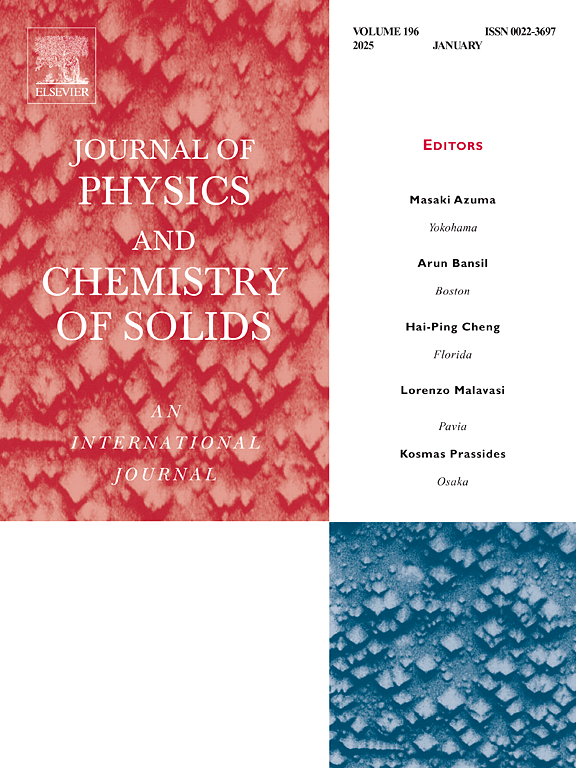用氟化合物钝化三维钙钛矿用于高效钙钛矿太阳能电池
IF 4.9
3区 材料科学
Q2 CHEMISTRY, MULTIDISCIPLINARY
引用次数: 0
摘要
钙钛矿太阳能电池(PSC)实现了单结电池27%的认证功率转换效率(PCE),这表明了成为下一代太阳能电池的巨大可能性。然而,不同的异质结界面会产生缺陷位点,导致非辐射复合,从而降低器件的稳定性和有效的电荷提取。减少缺陷位点的最有效策略之一是表面钝化,它抑制了界面和钙钛矿层体的非辐射复合。研究表明,在(Cs0.05MA0.05FA0.9Pb(I0.95Br0.05)3)钙钛矿薄膜中加入三氟甲磺酸铵(AFS)、三氟乙脒(TFA)和四氢呋喃胺(TFF)可以钝化缺陷部位。同时含有Lewis酸和Lewis碱的AFS分子能够有效结合缺陷位点和树形分子之间的晶界。它增加了晶粒尺寸和对环境刺激的内在稳定性。因此,AFS改良PSC的PCE最高,为17.69%。AFS的阴离子和阳离子性质有利于减少辐射复合,从而提高载流子寿命。AFS改性PSC更重要的是,在30%相对湿度和25°C的条件下,在没有封装的情况下测试2000小时后,其初始PCE保留了80%以上。本研究提供了一种钝化剂分子的设计,以有效钝化钙钛矿膜中的重组位点,从而扩大了钙钛矿膜的晶粒尺寸,提高了钙钛矿膜在湿度条件下的固有稳定性。本文章由计算机程序翻译,如有差异,请以英文原文为准。
Passivation of 3D perovskites with fluorine compound for highly efficient perovskite solar cells
Perovskite solar cells (PSC) achieved a certified power conversion efficiency (PCE) that was 27 % for single junction cell, which demonstrated a great possibility of being next generation solar cells. However, different heterojunction interfaces generate the defect sites, which cause the nonradiative recombination, resulting in the decreases the device stability as well as an efficient charge extraction. One of the most effective strategies to reduce the defect sites is the surface passivation which suppress the nonradiative recombination at the interface and bulk of the perovskite layer. Herein, it was demonstrated that the ammonium trifluromethansulfonate (AFS), trifluoroacetamidine (TFA), and tetrahydrofurfuryamine (TFF) were applied into the (Cs0.05MA0.05FA0.9Pb(I0.95Br0.05)3) perovskite film in order to passivate the defect sites. AFS molecule that contains both Lewis acid and base exhibited effective binding to the defect sites as well as the grain boundaries among the tree molecules. It increases the grain size and intrinsic stability to the ambient stimuli. Thus, the AFS modified PSC demonstrated the highest PCE of 17.69 %. The anion and cation nature of AFS facilitates the decrease of the radiative recombination, which boosts the carrier lifetime. AFS modified PSC more importantly retains more than 80 % of its initial PCE after 2000 h of being tested without encapsulation at 30 % relative humidity and 25 °C. This study provides a design for the passivator molecule in order to effectively passivate the recombination sites in perovskite film, which resulted in an enlarged grain size and an increase of the intrinsic stability to the humidity condition.
求助全文
通过发布文献求助,成功后即可免费获取论文全文。
去求助
来源期刊
CiteScore
7.80
自引率
2.50%
发文量
605
审稿时长
40 days
期刊介绍:
The Journal of Physics and Chemistry of Solids is a well-established international medium for publication of archival research in condensed matter and materials sciences. Areas of interest broadly include experimental and theoretical research on electronic, magnetic, spectroscopic and structural properties as well as the statistical mechanics and thermodynamics of materials. The focus is on gaining physical and chemical insight into the properties and potential applications of condensed matter systems.
Within the broad scope of the journal, beyond regular contributions, the editors have identified submissions in the following areas of physics and chemistry of solids to be of special current interest to the journal:
Low-dimensional systems
Exotic states of quantum electron matter including topological phases
Energy conversion and storage
Interfaces, nanoparticles and catalysts.

 求助内容:
求助内容: 应助结果提醒方式:
应助结果提醒方式:


